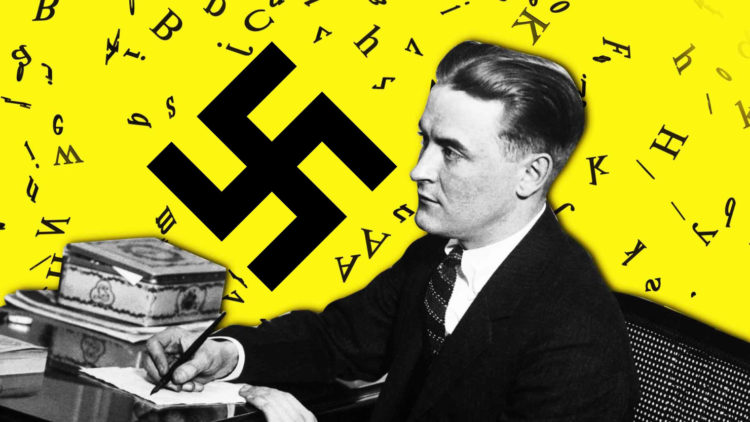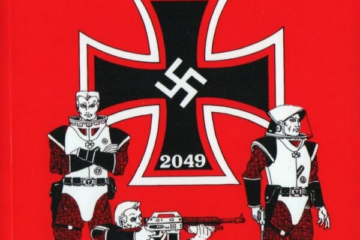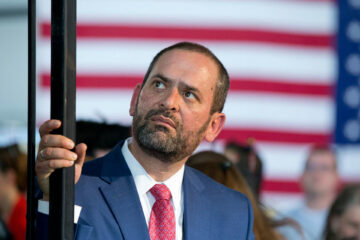The Swastika Holding Company
by Douglas Mercer
F. SCOTT Fitzgerald’s The Great Gatsby holds the honorable distinction of being the only book published prior to 1945 that contains the words “swastika” and “holocaust.” But that’s the least of it.
Was F. Scott Fitzgerald a “racist”?
Legions of indoctrinated American high school English teachers never dream of such a thing; like good little goys these teachers teach that The Great Gatsby is about the hollowness of the American Dream, but that’s a lie. It’s about how the American Dream was corrupted by Jews and racial aliens.
As the book opens, a character asks if the narrator has read a book called The Rise of the Colored Empires by “that man Goddard,” a book about the coming racial swamping of the White world by the colored one.
Those same English teachers assume unquestioningly that the sophisticated Fitzgerald must be satirizing such “racist” thoughts, but it’s simply not true.
He was endorsing them.
Critics have puzzled over the name Goddard. There’s Lothrop Stoddard who wrote The Rising Tide of Color Against White World-Supremacy. And then there’s Madison Grant who wrote The Passing of the Great Race, about the coming White race suicide.
Lazy scholars assume that Fitzgerald took the G in Grant and combined it with Stoddard to get Goddard.
But our subtle author is more subtle than the lazy scholars.
For there was also a man named Goddard, an American psychologist and eugenicist. He wrote a famous book called The Kallikak Family: A Study in the Heredity of Feeble-Mindedness. He also coined the word “moron,” and was the first to translate the Binet IQ Test from the French (he distributed 22,000 copies of the translation). He also publicized the famous Army IQ Tests, when, during World War 1, the government was able for the first time to measure the skull size and perform IQ tests on a massive amount of men. He also wrote about racial differences in IQ.
Heredity, eugenics, sub-mentals, measuring skulls, racial disparities in IQ — this was everything that Franz Boas wanted to get rid of when he said he wanted to “break the Nordic spell.” And it was also everything Boas did get rid of, driving Darwin out of the social sciences.
So that was “that man Goddard.”
Apparently Fitzgerald was very well-versed in the cutting edge of American scientific “racism.” And when he started the book, scientific racism was very much on his mind.
In addition Grant, Stoddard, and Fitzgerald all shared the same publisher, Scribners. Charles Scribner was a “notorious racist” himself.
The 1920s was the era of immigration restriction. Did Fitzgerald weigh in on this momentous issue? He did.
In 1921, after traveling to Europe, he wrote to Edmund Wilson that only those Europeans of purest blood, and that were most similar to America’s founding stock, should be allowed to immigrate to America.
So much for the dreamy sophisticate of every English teacher’s dreams.
He wanted to perpetuate the “Nordic spell”; he wanted a White ethnic self defense; he wanted the continuation of Anglo-Saxon heritage.
After the First World War the song said “How’re you going to keep them down on the farm, after they’ve seen Par-ee?”
It was a good question.
The great theme of American literature in the 1920s was the alleged stifling complacency of small town America, and the liberating power of the big cities on the East Coast. There was Sherwood Anderson’s caustic portrayal of small town life in Winesburg, Ohio. And more famously there was professional sneerer Sinclair Lewis and his Main Street, and his Babbitt, the depiction of normal Americans as smug and narrow minded, as being given to materialistic complacency and unthinking conformity. According to Lewis they were also very likely to be in the Ku Klux Klan as well — or at least the Knights Of Columbus.
It was Lewis who facetiously said “It Can’t Happen Here,” meaning that fascism was always lurking just around the corner.
Fitzgerald turns this hatred of small-town American life on its head.
His book starts out with his staid grandfather telling him to be forgiving, that not everyone has been made aware of the “fundamental decencies.”
The fundamental decencies — this is going to be a book for the decent folk, the salt of the earth, the heartland, and a warning of the perils and dangers of the big city.
In contrast to old American proprieties, what does the narrator find in Manhattan? He finds “careless people,” wealthy drunkards, a twit female tennis player, people having continual parties on blue lawns, drinking champagne, people cheating on each other, and crass and corrupt materialism.
He finds a miniature Weimar; he finds immorality; he finds degeneracy; he finds deracinated cosmopolitanism, a rootless world. At the book’s end he returns back West, to the heartland, disgusted by what he saw.
In the 1920s, the Jew Walter Lippmann was the mouthpiece for the East Coast swells. From his Jewish perch he sneered that America was a “nation of villagers” — small timers, hicks, rubes, hillbillies, troglodytes, inbred, backwater, backward, regressive “villagers.”
Today we have “flyover country.”
Jews never let up.
The 1920s was the era of the Jew Horace Kallen and misfit Randolph Bourne and their belief that the Anglo-Saxon world should give up its identity in the name of cosmopolitan “refinement.” Soon high school history textbooks would supplant settler ideology with melting pot theory; they would downgrade Anglo identity and replace it with the “American Creed” — the idea that America is an idea, and that idea is equality.
But that perfect Anglo world, that nation of villages, was the perfect creation of Thomas Jefferson. He warned that once wealth and people were concentrated in the big city then the country, the homeland, was dead. Cosmopolitanism was a trap, a descent into Hell.
He was correct.
Fitzgerald’s book gives the old America its just tribute, its swan song, in a passage perfectly evocative: “That’s my middle-west — not the wheat or the prairies or the lost Swede towns but the thrilling, returning trains of my youth and the street lamps and sleigh bells in the frosty dark and the shadows of holly wreaths thrown by lighted windows on the snow. I am part of that….”
But this is a dying world.
For into this pastoral paradise, this former green land first witnessed with breathtaking awe by those first Dutch sailors, into this once beautiful world, comes corruption.
Into this world comes the Jew.
There is always a snake in the garden.
Wolfsheim; the name says it all, the Jew as predator, the Jew as wolf; he has hair pouring out of his nostrils; he is repulsive, degenerate, a bootlegger, a criminal, selling drugs in the pure land.
He also uses his Jewish money to fix the World Series. America’s pastime, the pastoral innocence of perfection, played on a green field; this is spoiled and corrupted by a Jew and his Jewish money; the green temple becomes a den of gamblers out to turn a quick profit at the expense of the unsuspecting boobs.
The message is clear as a bell.
The American Dream is corrupted by Jews, by racial aliens.
At one point after a late night the narrator is driving back into New York and he sees a startling sight. He sees what he calls “two black bucks” being chauffeured by a White man. Here Blacks are in charge, lounging, living the high life, being obsequiously catered to by a White servant.
It’s a world upside down; it’s the rising tide of color; it’s the passing of the Great Race.
The narrator then says that when you come into Manhattan you never know what you’ll see.
Something which remains true to this very day.
Very near the end of the book there is a business office with the name “The Swastika Holding Company.” In 1925 this name would not have rung the bells that it does now.
You can be sure that Fitzgerald did not pick this name randomly, that he had a very specific intent.
The Swastika Holding Company is a front organization for Wolfsheim, so it is immediately associated with Jews.
In 1923 Adolf Hitler became international news. Alongside Erich Ludendorff and others he participated in a failed coup attempt against the German government. Hitler’s views concerning Jews were also publicized, so just as Fitzgerald was writing his book the word “swastika” and Jews were thrust into the limelight together in the person of Adolf Hitler. Then, in Fitzgerald’s book, the word “swastika” and Jews were paired again, in a work which portrays Jews just as Hitler saw them.
So much for the high school English teacher’s “sophisticate.” Instead we have a hard-edged and clear eyed “anti-Semite.”
Something better by far.
So was F. Scott Fitzgerald a “racist”?
Another way of putting that is: Was F. Scott Fitzgerald a good old-fashioned American interested in preserving the old America, in preserving European Civilization, and preserving the European peoples?
Was he fully in favor of White ethnic self defense against the rabid onslaught of the rising tide of color?
With regard to the world of color, did he think that we had to, in the words of one of the book’s characters, “beat them down”?
You bet he did, and you bet he was.
You can be sure he fully understood the fundamental decencies.
* * *
Source: Author








And then there is Goddard the American rocket pioneer.
Great article!
“As we crossed Blackwell’s Island a limousine passed us, driven by a white chauffeur, in which sat three modish negroes, two bucks and a girl. I laughed aloud as the yolks of their eyeballs rolled toward us in haughty rivalry.”
Fitzgerald nailed it!
This is a very good article. Thank you.
….how about Alice on the other side of the mirror…..?